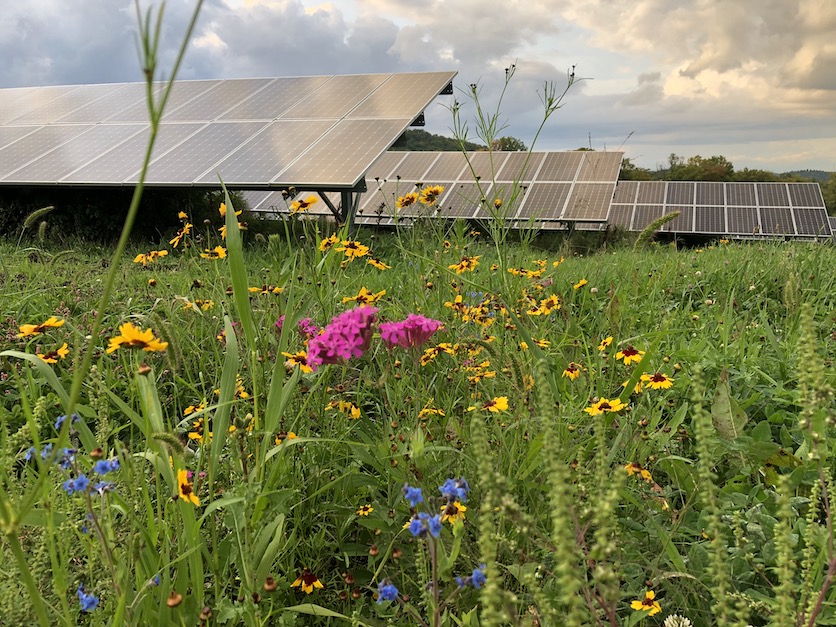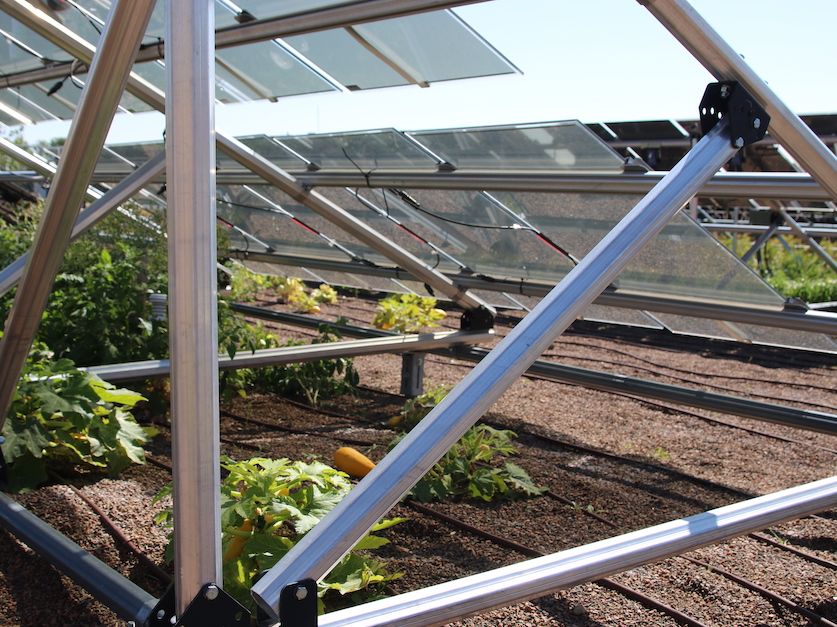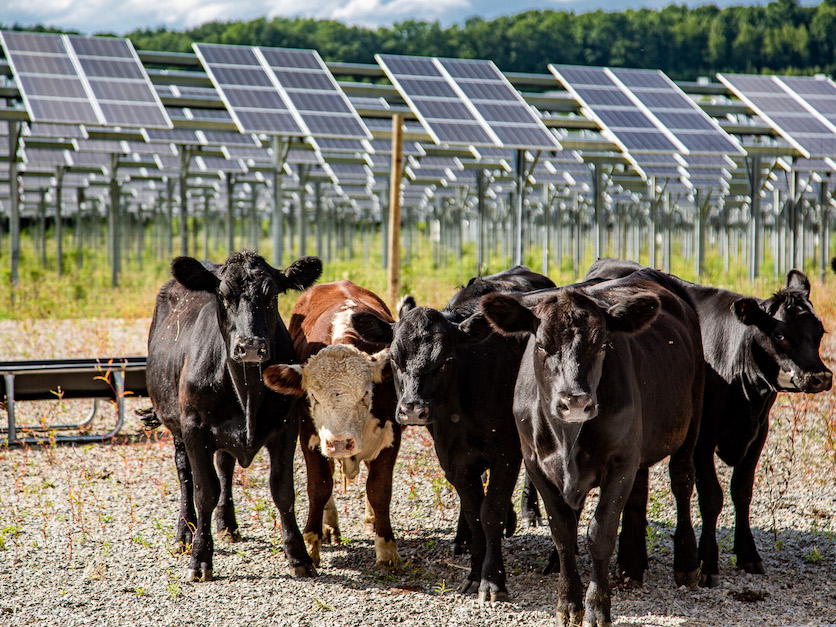A few years ago Nick Armentrout started seeing solar energy projects pop up all around his community in southern Maine.
“I was rather alarmed and frankly not in support of the idea," he recalls.
Armentrout keeps a herd of sheep on the organic farm he operates with his wife. Access to pasture is already a challenge in the Northeast, and he was concerned acres of solar panels would further decrease land available for farms.
But large-scale utility solar projects are often required to fence the site, seed grasses to protect against erosion, and keep vegetation from overgrowing. For Armentrout, that sounded like a pasture. He now helps farmers who need grazing land connect with solar developers who have it. This method of grazing sheep around solar panels is one example of agrivoltaics – a new industry that incorporates agriculture production and solar power generation on the same land.
Advocates of agrivoltaic systems say the technology can address concerns that the push to expand solar power is displacing valuable cropland, and some lawmakers want to use the next farm bill to ramp up funding for agrivoltaics research.
A proposal by Sens. Martin Heinrich, D-N.M., and Mike Braun, R-Ind., called the Agrivoltaics Research and Demonstration Act would authorize $15 million in annual funding for agrivoltaics research. The goal of the bill, in part, is to assess the compatibility of different species of livestock and crop types with agrivoltaic designs.
Heinrich, who chairs the Senate Agriculture Appropriations Subcommittee that writes USDA's annual funding bill, hopes the department, can eventually provide guidelines for agrivoltaic projects.
“The rub is basically making sure that you're maximizing both your horticulture, your power production, and that whatever you're using in terms of mechanized vehicles can fit under that,” he told Agri-Pulse.
“So if USDA can come up with some off-the-shelf designs, a lot more farmers will do dual cropping and then you have farmers that are just making a better return and stay in the business.”
The preliminary research into agrivoltaics shows potential for conservation benefits. Shade from the panels can protect grazing animals from heat stress or even reduce water use for shade-tolerant crops. However, the industry has a lot to learn before it can scale the practice and make it compatible for commodity crops and the large equipment they require.

Pollinator habitat is one way to make dual use of the land around a solar array. Photo by AgriSolar Clearinghouse.
Cathy Day, the climate policy coordinator for the National Sustainable Agriculture Coalition, is working on getting the Agriculture Resilience Act into the farm bill. Day said research is the first step to policy.
“Effective research often leads to a clearer understanding of benefits and drawbacks so that planners can make better decisions,” said Day.
The tension between land for renewable energy and land for farming is playing out across the country. Solar energy projects are often met with concern and pushback from local communities who fear the loss of farmland and rural character.
Solar energy is already rapidly expanding in the United States. The Department of Energy estimates that in order to meet the goal of a decarbonized energy sector by 2050, over 10 million acres of land will need to be covered with solar panels, 90% of them in rural communities.
In response to this rapid energy infrastructure expansion, some local governments have adopted moratoriums on solar projects. And Rep. Mary Miller, R-Ill., introduced the No Solar Panels on Fertile Farmland Act and wants the federal government to halt incentives for renewable energy development.
Miller told Agri-Pulse “incentivizing solar panels being placed on this farm ground is just going to drive the farm ground prices up.”
Samantha Levy, who is conservation and climate policy manager for American Farmland Trust, said the concerns about loss of prime farmland are justified based on recent development.
“We have found that there are strong incentives for developers to look at prime farmland first because it tends to be the flatter, less rocky, well draining, already cleared, sunny land,” Levy said.
Levy said solar leases help keep farms viable by giving the farmer a source of revenue in an economically challenging industry – and that’s their decision. But she said agrivoltaic projects may be more agreeable to rural areas and “take us out of this sort of push-pull that we see communities in where projects get proposed and there's a lot of backlash.”

A solar garden producing squash in Colorado. Agrivoltaics with crop production is presently limited to hand-harvested products. Photo by AgriSolar Clearinghouse.
The first experimental projects were built just over a decade ago.
According to data from the National Renewable Energy Laboratory, there are 345 agrivoltaic operations in the country, with the majority of those sites hosting pollinator habitat. When it comes to grazing livestock or harvesting crops in solar arrays, there are just 77 projects.
Joe Czajkowski, who farms fruits and vegetables on 400 acres in Hadley, Massachusetts, covered two and a half of those acres with solar panels three years ago.
Due to Massachusetts state policy, the panels have to be eight feet off the ground. Czajkowski is growing broccoli underneath them and looking forward to further expanding agrivoltaics on his farm.
He’s hoping the presence of the solar panels will actually benefit his produce. Czajkowski located the panels on some of his farm’s most marginal land – it’s sandy and exposed to wind.
“You know what this field did best? It got crop disaster payments,” said Czajkowski. “We'd plant beets and they'd burn out in August.”
Czajkowski’s agrivoltaics installation also includes irrigation equipment.
Don't miss a beat sign up for a FREE month of Agri-Pulse news! The latest on what’s happening in Washington, D.C. and around the country in agriculture, just click here.
“Now that the field is somewhat shaded, somewhat protected from the wind, and now that it has irrigation, I think I'm going to be able to do better,” Czajkowski said.
Czajkowski worked with Jake Marley, owner and manager of Hyperion Systems, to design an agrivoltaic program to work best with his farm.
“He sort of became interested in, if not interested, obsessed, with this idea of installing solar in a way that would not take the land out of production,” Marley said.
His father’s partnership with the University of Massachusetts developed the first agrivoltaic project in the country and was the impetus for the state to develop its dual-use incentive program.
Due to the design specifications of solar projects that include agrivoltaics - higher panels, irrigation, room for farm labor and equipment - they can cost more.
But agrivoltaic systems like Czajkowski’s and others designed by Hyperion are generally just a few acres, while utility-scale solar projects often span thousands of acres, raising concerns that they are gobbling up farm land.
Braun, who is a member of the Senate Agriculture Committee, said the conflicts over land use are why agrivoltaics needs more research.
“It seems like anything that has a transmission line near it has got a prime farm field under it. So we gotta get that worked out," he said.

An elevated racking system allows for cattle grazing at Grafton Solar in Massachusetts. Higher panels require more steel and can increase project costs. Agrivoltaics advocates would like policy to incentivize developers to design for livestock and a variety of farm use in their projects. Photo by AgriSolar Clearinghouse
The Department of Energy also sees agrivoltaics as a way to make utility scale solar projects more welcome. They’ve been funding research into agrivoltaics since 2015 with the National Renewable Energy Laboratory.“We are looking for ways of reducing land use conflicts to make siting for solar easier, faster, and less expensive,” Michelle Boyd, program manager in the Solar Energy Technologies Office, told Agri-Pulse.
For solar energy industry advocates like Brian Ross at the Great Plains Institute, a group that advocates for renewable energy, agrivoltaics is key to expanding solar power production. Ross said siting conflicts are one of the major barriers to solar energy deployment. If incorporating agriculture into solar projects can address community concerns, it's worth the additional costs.
However, Ross said focusing solely on marginal farmland is easier in some places than others.
“There are places where it's hard to spit without hitting prime farmland, you know, it's 80% of the county. And if you say, you're going to keep it (solar) off of prime farmland, you're really dramatically limiting where you can do it.”
Armentrout, the Maine farmer who now works with the American Solar Grazing Association to pair farmers who need pasture to solar developers who need vegetation management, said the goal of agrivoltaics is to integrate farming and energy production.
“People live over here and grow veggies over here. We do our nutrient management over there and we graze animals or we feed animals over there. We produce energy and oil over there in another spot,” said Armentrout.
“We don't think about it all on the same acre.”
For more news, go to Agri-Pulse.com.


